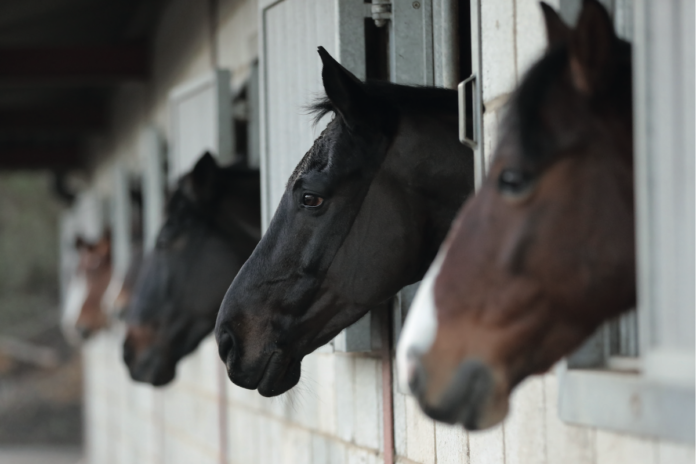Equine Asthma: What can owners do?
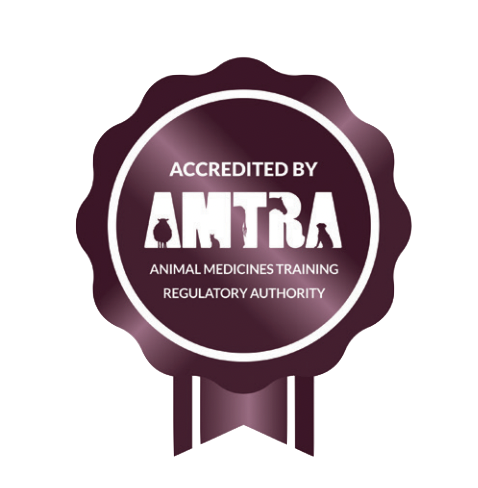
By Kate Hore RNutr(Animal) R.Anim.Technol (Cert) head nutritionist, NAF
CPD points in a given period of time in order to retain their qualification. RAMAs/SQPs who read this feature and submit correct answers to the questions below will receive two CPD points. For more about AMTRA and becoming a RAMA/SQP, visit www.amtra.org.uk
Maintaining respiratory health is a year-round challenge, but certainly one we become very aware of as we head towards winter, the season of increased stabling for horses and ponies.
One of the issues we, as equine advisors, can face is sometimes confusing terminology from customers and their vets. Respiratory health seems to have more than the usual number of acronyms and descriptors, which are ever evolving. This article hopes to simplify those customer questions, and help you advise what the owner can do to maintain healthy, clear airways.
HOW BIG IS THE ISSUE?
Respiratory disease is a common, highly relevant condition in domestic horses, split into two areas.
First is the risk of infectious disease, commonly including Strangles, Equine Influenza and Equine Herpesvirus (EHV). However, those conditions are outside the scope of this article, and here we are concentrating on the second area, that of non- infectious disease, now normally under the umbrella term of ‘Equine Asthma’ (EA).
Non-infectious respiratory disease alone is a considerable threat to equine health and performance. Studies show in the northern hemisphere, the incidence of Equine Asthma is at least 14%, a figure supported by data from British horse owners. However, that may be a conservative figure. Current research suggests nearer to 20% is likely, and sub-clinical respiratory stress is recognized in at least 80% of racehorses.
Respiratory disease is closely linked to performance, and therefore for reasons of both equine welfare and athletic performance, we should be advising good management of respiratory health to all horse owners.
WHAT IS THE PROBLEM?
The term Equine Asthma now covers all those terms we have previously known, such as Heaves, Broken Wind and COPD, and is split into two – Inflammatory Airway Disease (IAD) and Recurrent Airway Obstruction (RAO).
IAD may also be referred to as ‘mild-moderate Equine Asthma’ (mEA) and, as the name suggests, signs can be subtle, including poor performance and occasional coughing, but the breathing will be normal at rest. IAD may affect any type or breed of horse, but is generally seen in, though not limited to, younger animals. RAO is most usually seen in older horses, those over seven years. The signs are likely to be more severe and long lasting, and may be referred to as ‘severe Equine Asthma’ (sEA). RAO includes the sub-set of SPARAO, Summer Pasture-associated Recurrent Airway Obstruction, which most customers will describe more simply as a ‘pollen allergy’ or ‘hayfever’.
The differences are shown in Table 1.
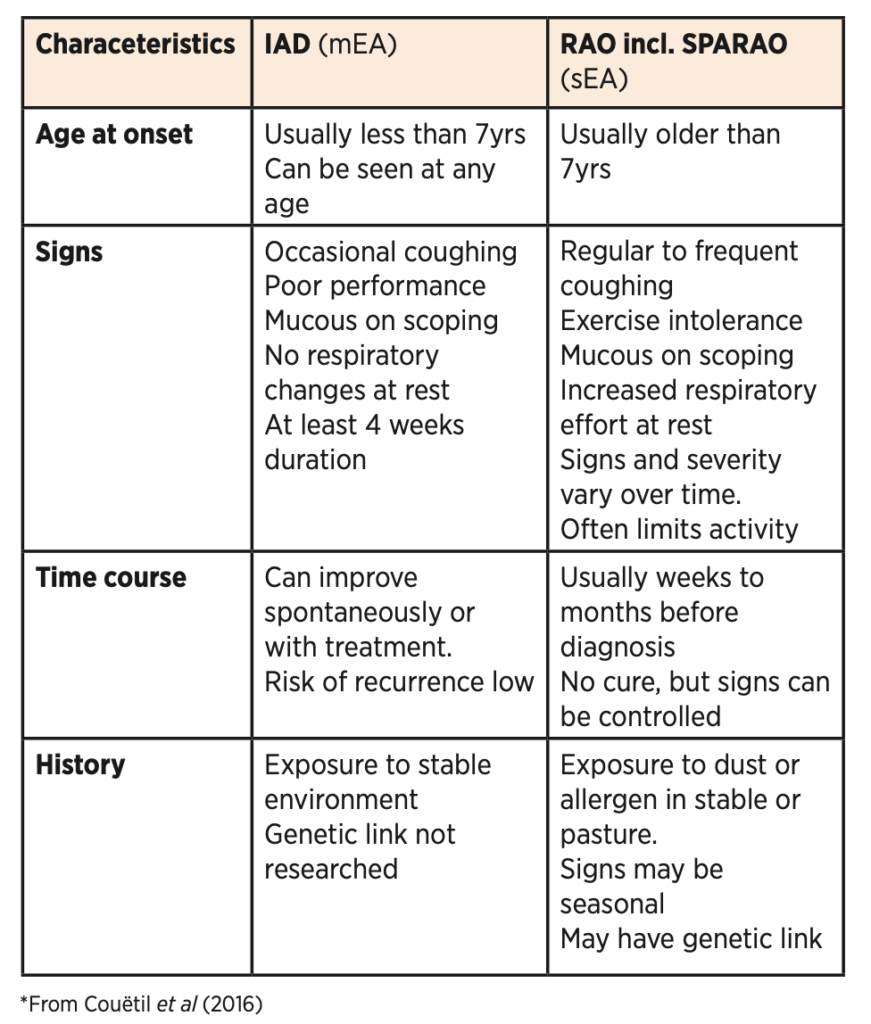
CAN NUTRITION HELP?
Looking at the diet can help the EA individual in a couple of different ways. Firstly, as horses and ponies increasingly rely on preserved forages over winter, we should recognize those as a potential source of dust and spores, and manage appropriately.
Changing to an ensiled, well-preserved haylage can help, as they typically have a lower dust burden than dry hay. If feeding hay, the practice of soaking or steaming is very useful. Take care not to oversoak, as nutrients will be leached and always ensure fresh water is used each time.
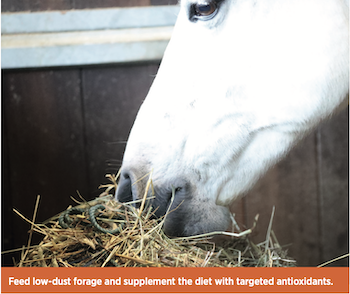
Remember, the idea of soaking or steaming is not to wash dust off the forage, but to swell the dust so that it is swallowed rather than inhaled. For this reason, it is important not to allow treated hay to dry before feeding, as the problem will return.
Secondly, targeted nutritional support can play a significant role. Traditionally, herbal support of the respiratory system is well- known and dates back at least as far as the Great Plague of London in the 17th century. Coming up to date, bioactive components of plants are again being investigated as part of the global defence against modern respiratory pandemics such as Covid-19.
In equine health too, the role of targeted nutrition is well recognized. Supplementing the diet with targeted antioxidants has been established in horses for over 20 years.
Broad spectrum herbal antioxidants have been successfully researched, alongside straight antioxidants such as vitamin C. Unlike humans, horses can manufacture vitamin C themselves and don’t have a dietary requirement for it at maintenance. However, at times of stress, such as respiratory disease, an increased requirement is recognized.
Specific herbs, such as echinacea, are advised for inclusion in the supplement. Equine specific research supports echinacea as stimulating immunocompetence, hence helping the horse’s immune system against the stresses of EA.
Finally, adding a ‘glug’ of oil to horses’ diets is commonplace, particularly over winter for general health. Advising the right type of oil can also help respiratory health.
Research shows that an addition of Omega 3 fatty acids to the diet can also provide a benefit for the EA affected horse. However, most plant-based oils such as corn oil, rapeseed, or sunflower oil (typically cheap ‘vegetable oil’) are high in pro-inflammatory Omega 6, and provide little or no Omega 3. Instead look for an oil with a positive omega 3 contribution such as linseed, algal, or an omega 3 based blend.
MANAGEMENT TIPS
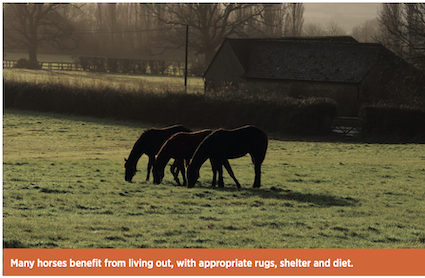
- Turn out as much as possible. Most sEA horses* will benefit from living out full time, with appropriate rugs, shelter and diet.
- Feed low dust forage, supplement the diet with targeted antioxidants.
- Mix bucket feed with an Omega 3 oil.
- Feed from the floor to aid natural drainage.
- Choose low-dust bedding and ensure good ventilation in stables.
- Ensure horses are not in the stable when mucking out, and allow particles to settle before they return.
- Monitor riding arenas; take care with, dust, silica and number of horses using the school concurrently.
Finally let’s not forget the respiratory health of horse owners themselves. Research shows that those caring for horses are at increased risk from respiratory disease. In the last couple of years, we’ve all become used to wearing a face mask, and using one while mucking out would be advised.
*SPARAO horses may be better housed during the day at peak times, spring and summer.
Selected References**
- Couëtil L et al. Equine Asthma: Current Understanding and Future Directions. Frontiers in Veterinary Science. 2020, 30 July.
- Hotchkiss JW, Reid SW, Christley RM. A survey of horse owners in Great Britain regarding horses in their care. Part 2: Risk factors for recurrent airway obstruction. Equine Vet J. 2007 Jul;39(4):301-8.
- Kirschivink N. et al Effect of nutritional supplementation on systemic and pulmonary antioxidant status, airway inflammation and lung function in heaves –affected horses. Equine Veterinary Journal. 2002. 34,7. 705-12
**Contact NAF if full list of references is required.

ABOUT ETN’S RAMA/SQP FEATURES
ETN’s series of CPD features helps RAMAs (Registered Animal Medicines Advisors/SQPs) earn the CPD (continuing professional development) points they need. The features are accredited by AMTRA, and highlight some of the most important subject areas for RAMAs/ SQPs specialising in equine and companion animal medicine.
CPD points in a given period of time in order to retain their qualification. RAMAs/SQPs who read this feature and submit correct answers to the questions below will receive two CPD points. For more about AMTRA and becoming a RAMA/SQP, visit www.amtra.org.uk










